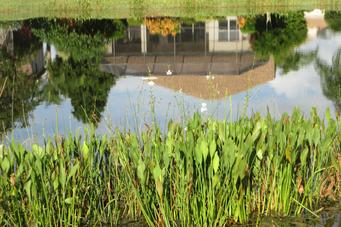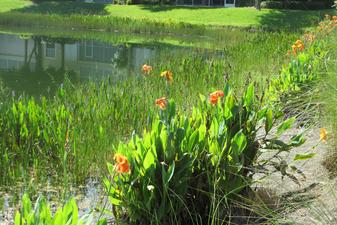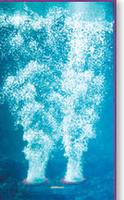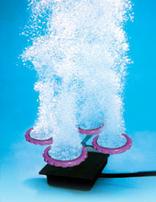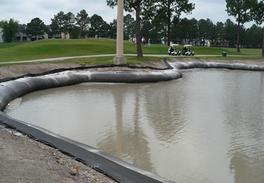Lake Management
The lake shore (or littoral zone) is the shallow area along the shoreline of a lake or pond which supports diverse communities of rooted plants and serves as food, habitat and protective shelter for fish, insects, amphibians and other aquatic animals. These diverse plant communities also provide cover and nesting materials for a variety of wild birds and mammals. Management of littoral zones is often necessary in systems altered by humans.
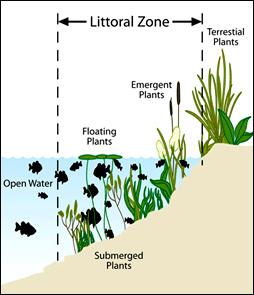
Typical littoral zone problems associated with human activities include:
- Shoreline erosion
- Algal blooms due to input of excess nutrients
- Overgrowth of invasive exotic plants
- Removal of protective vegetation needed for fish habitat and cover
Weeds are critical to our eco system…
Aquatic plants are a natural part of most lake communities and provide many benefits to fish, wildlife, and people. In lakes, life depends–directly or indirectly–on plants. They are the primary producers in the aquatic food chain, converting the basic chemical nutrients in the water and soil into plant matter, which becomes food for all other life.
Aquatic plants serve many important functions:
Provide fish food
More food for fish is produced in areas of aquatic vegetation than in areas where there are no plants. Insect larvae, snails, and freshwater shrimp thrive in plant beds. Sunfish–Minnesota’s most sought-after game fish–eat aquatic plants in addition to aquatic insects and crustaceans.
Offer fish shelter
Plants provide shelter for young fish. Because bass, sunfish, and yellow perch usually nest in areas where vegetation is growing.
Improve water clarity and quality
Certain water plants, like bulrushes, can absorb and break down polluting chemicals. Nutrients used by aquatic plants for growth are not available to algae. This reduces algae abundance improving water clarity. Aquatic plants also maintain water clarity by preventing the re-suspension of bottom sediments. Algae, which thrive on dissolved nutrients, can become a nuisance when too many submerged water plants are destroyed.
Protect shorelines and lake bottoms
Aquatic plants dampen the force of waves and help prevent shoreline erosion. Submerged aquatic plants also weaken wave action and help stabilize bottom sediment.
Provide food and shelter for waterfowl
Many submerged plants produce seeds and tubers (roots), which are eaten by waterfowl. Bulrushes, sago pondweed, wild celery, and wild rice are especially important duck foods. Submerged plants also provide habitat to many insect species and other invertebrates that are, in turn, important foods for brooding hens and migrating waterfowl.
Improve aesthetics
The visual appeal of a lakeshore often includes aquatic plants, which are a natural, critical part of a lake community. Plants such as water lilies, arrowhead, and pickerelweed have flowers or leaves that many people enjoy.
Provide wildlife habitat
Littorals provide nesting and resting habitat for ducks and loons, avocets and snipe, and a myriad of other bird species. Frogs deposit their eggs on the plant roots, salamanders cruise the waterline, turtles haul out to bask, and glinting blue dragonflies dart and hover.
Lake Aeration:
Earlier we identified three significant factors that impact a lakes condition. The impacts of two of these factors, oxygen and temperature, can be significantly reduced through the use of aeration. The following are some of the biological benefits of an aeration system:
- Increased oxygen for fish populations
- Increased oxygen for improved bottom water quality
- Increased oxygen for rapid decomposition of organic matter
- Increased oxygen to help control undesirable bacteria
- Reduced water stagnation
Increased circulation and mixing to reduce temperature differences in the water column
Aeration can be accomplished by a mechanical aerator or an underwater diffuser aerator. Mechanical aerators agitate water to produce water/ air contact, while underwater diffusers introduce air bubbles from a depth to achieve oxygen transfer and mixing. Diffuser type aeration systems are replacing mechanical aerators because of their low maintenance, reliability, safety, flexibility and overall efficiency. Diffuser aerators are also far more efficient at removing gases such as ammonia and carbon dioxide.
A diffuser type aerator works along the same principles of an aerator in an aquarium only on a much larger scale. An air compressor is located, in a noise proof box, on the bank of the lake. A series of weighted hoses transfer the air from the compressor to a series of diffuser stones that are placed on the bottom of the lake at pre-determined locations. The diffuser stones produce air bubbles that are an average of 3mm in size and which is easily absorbed into the water raising the dissolved oxygen or D.O. level in the lake. Additionally, the air bubbles expand and spread out as they rise. The displacement of the rising air bubbles causes a significant upward water current thus efficiently mixing the cooler bottom layer of water with the warmer surface layer of water at rates of up to 2,000 gallons per minute per diffuser. This mixing reduces the overall water body temperature, which leads directly to a reduction in algae and other aquatic weed growth. One diffuser type aerator, with 3 diffuser stones, can efficiently aerate up to 10 acres of lake.
Lake Shore Erosion / Maintenance:
Is your house getting closer to the lake each year as your shoreline erodes? Several factors contribute to this type of erosion. Wave action from wind, boats and storms can destroy the shoreline. As these waves crash into the unprotected shore, shoreline sediments are washed into the lake and re-deposited elsewhere. Fluctuating lake levels are one of the most common causes of shoreline erosion. Since most of the lakes in Florida are man made reservoirs, the vegetation growing on the lake’s edge is often not suited to alternating wet/dry conditions. As the water level rises, it covers the roots of upland trees and grasses. Then the water-covered roots don’t get enough oxygen. If that doesn’t kill the plants, the roots are then exposed by erosion when the water recedes.
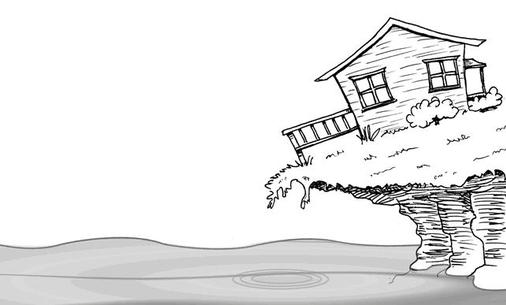
Before you begin an erosion control project…
First, step back, and determine the cause and extent of shoreline erosion at your lake. Is this due to wind action? If so, maybe only the windward side is affected, and there may not be anything you and your lake organization can do to prevent it. Is the erosion caused by boat action, construction, or ice? Perhaps no-wake zones, construction ordinances, or ice break-up would address these issues.
Next, is the problem serious enough to address? How much of the shoreline has an erosion problem? What is different in the areas that don’t seem to be eroding? Are all the property owners willing and able to address this problem?
Last, what is the overall goal for the lake? Is this lake primarily used as a fishing, boating, swimming or drinking water lake? How do the lake owners want the lake to look; natural with a vegetated boarder, reinforced with a seawall, rock riprap, or some of each?
Methods of Erosion Control
The three types of standard erosion control are vegetative, structural, and combination. None of these methods is right for all situations. It is important to match the type of erosion, and lakeshore environment, to the control method.
Vegetative erosion control is the use of native plants and trees to stabilize the soil near the shore. Spikerush, arrowhead and pickerelweed can be used in the water to lessen the effects of wave action. These plants are very hardy and can withstand changes in lake water levels. On shore, landowners can use shrubs, willows, to shade the lot and reduce erosion.
Vegetative – Advantages
- Trees shade the lake. This can lower water temperatures.
- Increased spawning ground for fish.
- Cuts down on mowing, and therefore less maintenance.
- Soil and fertilizers are filtered through buffer strip, so less ends up in the lake.
- Ducks favor this type of habitat – less food source for geese.
Vegetative – Disadvantages
- Increases chance encounter with water snakes, ticks.
- Does not provide “neat” shoreline view with park-like grass.
Structural erosion control involves building either a sea wall or the placement of rock riprap. Use of riprap is the most common type of erosion control. It involves the positioning of rock on the shoreline, often over a special filter cloth. Rock size is dependent on wave height, and bank slope. Obviously, the harder the waves are hitting the shore, the bigger the rock size required. This type of construction requires a 404 permit from the Corps of Engineers, and a 401 permit from the Department of Natural Resources.
Riprap – Advantages
- Provides some structure for smaller fish/crayfish species.
- May prevent further erosion of site, if correctly installed.
- May provide immediate erosion control – reduced wave action.
Riprap– Disadvantages
- Riprap protects only the land immediately behind the barrier, and not the adjacent areas. In fact, erosion may increase by wave reflection from the structure.
- Riprap does not reduce water temperature, or filter soil from the land above the lake.
- Riprap must be done correctly to have desired effect, the initial cost is high, and it does require maintenance as rock settle and fall into the lake.
- Riprap does not maintain natural look of the lake. Lakes with a riprap shore are less likely to have ducks or geese – waterfowl like to be able to walk out of water.
Combination of shoreline erosion control uses both of the previous methods. Riprap is first installed on the site, with soil added to the areas away from the water’s edge. Tree plantings are then scattered within the rock riprap. Permits are required for this type of construction.
Combination– Advantages
- Immediate erosion control, with future benefits of vegetation.
Combination– Disadvantages
- Most expensive, since you have to do both riprap and plantings. Choose plants, such as willows, that are able to withstand fluctuations in water level.
- Combination does require some maintenance to keep trees and rock in place. Usually only one tree species is planted on the site.
By stabilizing your shoreline you can prevent loss of property, and improve water clarity. The trick is knowing which method is right for your situation.
Geo Filter Tube:
Geo Filter Tube is environmentally friendly and manufactured locally, within the State of Florida. Composed of a high strength filter weave fabric, the Geotube is a durable and lasting erosion prevention device with unique physical and hydraulic properties that satisfy high flow rates, prohibit clogging and eliminate damage from tilapia fish. Once installed, the geo-tube will improve water quality by filtering irrigation and stormwater run-off, eliminating fertilizers, chemicals, sediments, and contaminants.
